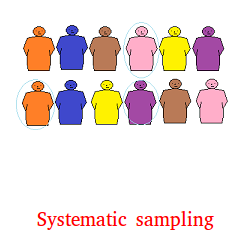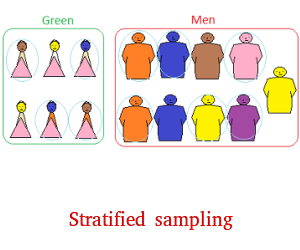Common sampling methods
The five common sampling methods of choosing a sample are listed below along with some good explanations.
Random sampling

In random sampling, each member of the population has some chance of being selected.
If the chance of being selected is the same for each member of the population, then the random sample is called simple random sample.
A computer is often used to generate telephone numbers randomly.
Convenience sampling
The word convenience no doubt reminds you of something that is convenient or something that requires little effort.
This is what convenience sampling is about. The sampling is done that way because it will require little effort.
May be you want to know the number of students who love to play basketball in the state of California.
You could use random sampling by calling people or you could just ask a student to interview his schoolmates.
This is quite convenient since you don't have to do anything.
To make it even more convenient, the researcher may choose schools that are close to his house.
Systematic sampling

In systematic sampling, we first select a starting point randomly and then select every nth member of the population.
n is a whole number.
In the systematic sampling illustrated above, first the fourth member is selected.
Then, every 3rd member is selected afterward.
For 200 people, your sample will look like the following
4th, 7th, 10th, 13th, 16th, 19th, 22nd, 25th, and so forth.
Cluster sampling
In cluster sampling, The population is divided into clusters or groups. Then, some of these clusters are selected.
Finally, choose all members from those selected clusters.
Suppose a country has 20 cities.
First, you can divide the country into 20 clusters. Second, you may decide to choose 5 clusters or cities or groups randomly.
Finally, from these 5 cities, you can select all members.
Stratified sampling
In stratified sampling, you first divide the population into at least 2 non-overlapping subgroups or strata.
This could be done based on age, gender, nationality, etc.
Then, you draw a sample from each.
For example, you could have 2 subgroups made of men and women.

Notice that the proportion is 2 to 3 for both subgroups. The proportion has to be the same for all subgroups.